Rice grinder is a grain processing equipment that combines conveying, lifting, removing stone and grinding rice. In recent years, domestic rice processing equipment has developed rapidly, but the processed rice has poor whiteness and brightness, contains more cesium, and has a higher broken rice rate; during the processing of rice, the temperature rise is also large, so the taste is not edible when eating. Too good, need to be equipped with hoists and stone machines, resulting in a large area and investment. In addition, the power consumption of the single-unit combination is also relatively large. This is a big issue for the use of domestic rice machines because today's increasingly tense electric power and rising electricity prices cannot be considered. Based on the introduction, digestion, and absorption of the combination rice mill technology of the Japan Taihe Seiki Co., Ltd., our company has developed a combination rice mill with finished rice that is bright, white, contains very little cesium, has a low broken rice rate, and has a low temperature rise. , does not contain stone, less energy consumption and other significant features, and labor-saving operation, beautiful appearance.
This paper analyzes and studies the main structure, working principle, main technical parameters and characteristics of the combination rice grinder.
First, the main structure and characteristics of the combined polished rice machine
1. The overall structure and characteristics The machine is mainly composed of frame, hoist, stone machine, rice grinding machine (see Figure 1), most of which through the whole base assembly into one. The rice bucket on the platform is the feeding port, the screw conveyor at the lower part of the platform is the feeding mechanism, and the input port is the component that transfers the screwed material to the lower part of the elevator. There are also hoist outlets, belt covers, electric control boxes, operating panels and other components. The electric control box is installed at the rear of the rice grinder and the device controls the components in the box. The operation panel is mounted on the front of the rice grinder, and an operation button is provided on the operation panel to automatically process the brown rice according to the material level. The front of the machine is also provided with operation switch elements such as feed switch, fine whiteness knob and flow adjustment knob to adjust the precision and whiteness of switches and rice and proper flow. The finished product is discharged from the discharge port. The whole structure is novel, compact and easy to operate.

2. Frame structure and features Mainly includes the upper cover plate, frame body, screw conveyor, pulley, rice bucket and other components (see Figure 2). The platform is used for loading and supporting in the whole machine. The screw conveyer sends the material added from the rice bucket to the rear hoisting machine and the stone removal machine is installed on the upper cover plate.
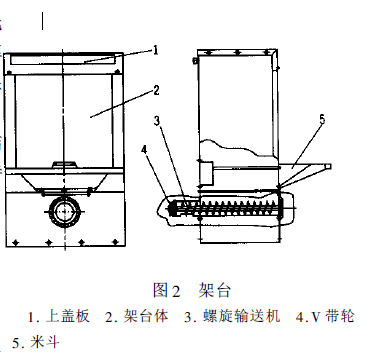
3. Hoist structure and characteristics It mainly consists of the body, power transmission device, lifting device, adjustable bearing seat, cleaning mouth and other parts (see Figure 3). The body is made of two sections butt joints. The lower part of the body is provided with a cis- and reverse-direction bi-directional feed inlet and is designed as a curved bottom plate, which can significantly reduce the stock. The upper part of the body is provided with a discharge opening and an adjustable bearing seat, and the position of the head wheel shaft is increased by rotating the screw rods at both ends, so that the center distance between the head wheel and the tail wheel is increased to achieve the purpose of tensioning the conveyor belt. The power transmission device includes a motor, a pulley, a V-belt, and a V-belt tensioning mechanism. The lifting device includes a head wheel, a tail wheel, a conveyor belt, a bucket, etc., which are driven by the power transmission device to lift the material to a desired height.
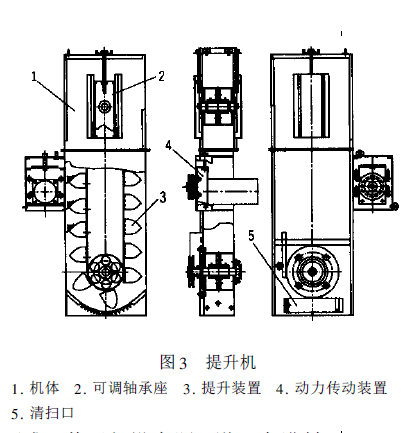
4. The structure and characteristics of the destoner include feed inlet, body, separation valve, row stone baffle, four-bar linkage, swing power system, balance system, transmission system, fan system, discharge port, transmission cover, Dust box, etc. (see Figure 4). The stencil hole of the sorting valve is an oblong slat hole, and the blown air passes through the mesh hole and is blown upwards obliquely upwards to blow the material upwards, and the shoulder-sill stone dropped to the mesh surface after oscillating is caught by the swelled hole edge. , And is constantly being oscillated into the row of stone area. The four-bar linkage includes links and a return spring to support the sorting valve and fan housing. The transmission system includes motors, pulleys, V-belts, etc., and is the power source part. The swing power system includes a swing shaft, an eccentric sleeve, a crank, and the like, and is a working mechanism that converts the rotation of the power system into swing. The balance system includes weights, eccentrics and other components to balance the vibration. The fan system includes fan shafts, fan blades, fan housings, and other components that create wind that fluidizes the material. The settled dust collects in the dust box in the lower part of the stone remover.
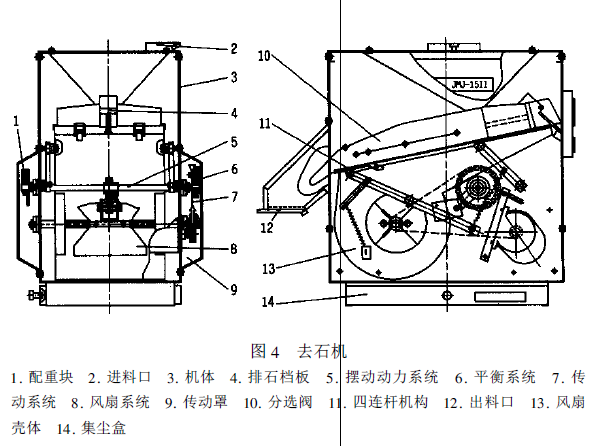
5. The structure and characteristics of the eel system As shown in Figure 5 and Figure 6, the eel component is fixed on the rice mill frame, and the main shaft rotates under the pulley. The main shaft is cantilever fixed by two self-aligning bearings. On the rice milling frame body, the fixing roller, the sending roller, and the enamel roller are sequentially set on the main shaft, and the hounds are connected, and rotate together with the main shaft. There is a helix on the outer circle of the roller, which is used to push the material forward. The niobium roller has an eccentric radial structure and two ribs in the axial direction to achieve the extrusion of the material. The grain feeding cylinder, the maggot boring cylinder, and the removing hoe net are fixed on the inner side of the rice grouting frame, and the squeezing roller and the boring roller in the axial direction and the main shaft form a whitening room together. The resistance arm and the resistance plate change the gap with the discharge outlet under the drive of the fineness degree knob, thereby changing the pressure in the whitening chamber, thereby adjusting the precision of the finished product meter. The card is connected to the feed switch to open and close the feed channel. The flow switch is rotated under the flow adjustment knob to change the opening of the feed channel, thereby changing the flow rate.
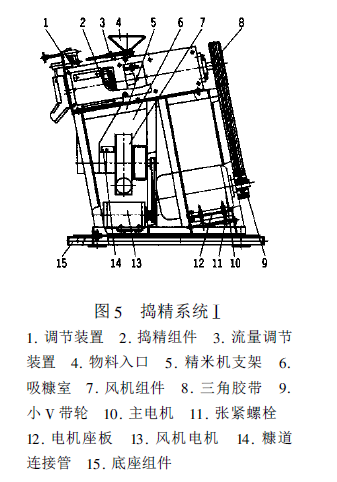
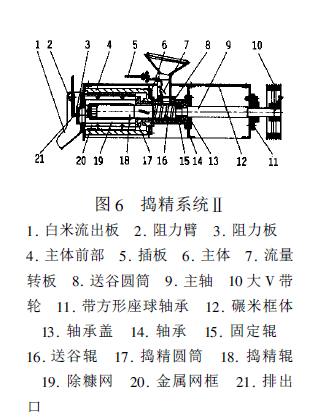
The rice mill stand is tilted forward, so that the caster assembly, the main motor, the pulley, etc. also tilt forward, which saves energy. The belt tension of the main motor adopts a more advanced hinge structure, which is simple, convenient, and reliable. The suction chamber and the fan assembly are connected by a manifold connecting pipe to suck out the sucker. The power required by the fan is provided by the fan motor, so that the fan can generate the required suction volume for milling. The impeller in the fan adopts a radial welded reinforced structure, which is easy to process and does not deform. The working principle of combination rice mill The working principle of combination rice mill is shown in Figure 1. The brown rice is conveyed from the rice bucket through the screw conveyor into the input port, lifted by the elevator, and entered into the stone removing machine through the discharge port. After going to the stone, it is discharged into the feed hopper of the rice grinding machine and enters the machine. The action of the valley cylinder advances along the axial direction. In the interior of the maggot chamber, the pressure is applied to the trough rolls, the feed trough cylinder, the niobium fine cylinder, the niobium fine roller, the niobium net, and the discharge outlet pressure. Between the brown rice, the brown rice, the loquat roller, and the rake net are rubbed and rubbed against each other, and when the rice granules reach the required precision, they are discharged from the discharge outlet. At the same time, the induced draft fan introduces air from the inner hole of the spindle into the refining chamber, which enhances the whitening effect of the polished rice and takes away some of the heat generated during the whitening process. The enthalpy is removed by the induced draft fan and discharged into the collector and collected and bagged. .
Second, the main technical parameters of rice grinding machine (1) processing capacity: 85 ~ 95kg/kw · h This parameter is affected by the operating environment temperature and brown rice hardness, when the environment temperature is low and the rice is harder, the processing capacity low.
(2) Spindle speed: The speed of 850r/min spindle speed has a greater influence on the movement speed and grind pressure of rice grain in the white room. For the pressure type rice machine, if the spindle speed is the roller speed is too fast, then the rice grain movement speed increases, the density of the rice grain fluid in the whitening room decreases, the whitening pressure drops, the rub off effect weakens, and the whitening effect becomes worse; If the rotational speed is too low, the axial propulsion of the rice grains in the whitening room will be weakened, and the movement speed of the rice grains will be reduced. As a result, the output of the rice mill will be reduced and the power consumption will be increased. At the same time, the rice grains will be unevenly rolled due to poor rolling performance. , The accuracy has dropped. Therefore, we determined the spindle speed to be 850r/min through a large number of performance tests.
(3) Stone removal efficiency: The stone removal efficiency is up to 100% by using the shoulder stone at the standard content and the prescribed treatment amount.
(4) Length-diameter ratio and surface shape of the niobium masterbatch: The diameter and length of niobium masterbatch are directly related to the number of times the rice grain is subjected to grinding and the amount of grinding area in the whitening room. When the rice is milled with a larger diameter and longer length rice grinder, less broken rice is produced and the temperature rise of rice grains is lower, which is beneficial to improving the technical effect of the rice mill. In order to ensure the technical performance of the rice mill, the length and diameter of the nibbling roller should be in a certain proportion. After several performance tests, a suitable aspect ratio of 2.5:1 was obtained. The niobium fine roller has an eccentric cross-sectional structure and the eccentricity is such that it has a gradually expanding grind pressure on the rice during the rotation; the niobium fine roller has two symmetrical ribs in the axial direction, and the rib height is generally 6~9mm. Rigging mainly plays a tumbling effect on rice grains. If the eccentric roller eccentricity is too large or the standing ribs are too high, the whitening and tumbling effects will be too intense and damage the rice, affecting the rice milling effect.
Related equipment: Artificial climate chamber Insect killer Nitrogen determination apparatus
Crane Scale
Crane scale :
Electronic crane scale OCS introductions:
We supply wireless electronic crane scale and LED display crane scale.
These flexible crane scales make it easy to measure suspended loads.
Designed with safety in mind, each scale features a standard remote control that allows operation at a safe distance.
The rotating hook with safety catch ensures stability and keeps the suspended item securely in place.
High-contrast red LED display and indicators are easy to read in any lighting conditions.
A handy hold function keeps the reading visible on the display after the weight is removed, allowing the operator to safely record the weight.
Each model offers a built-in rechargeable battery, which allows the scale to be used in areas where power is not available.
Equipment has been a world-class scale and balance manufacturer for more than 40 years.
Trust us to bring you quality products with a wide range of features to handle a variety of applications
Digital wireless crane scale

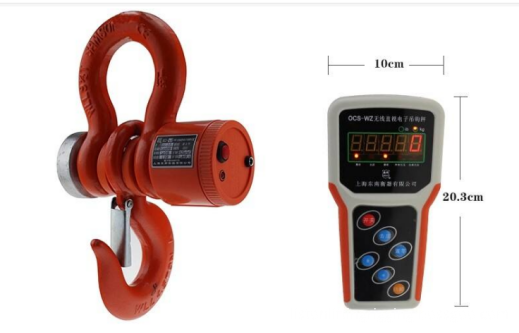
Specification:
|
Product Name
|
Wireless 2T To 15T OCS Crane Scale
|
|
Item No.
|
OCS-WZ-3T
|
|
Item Type
|
Digital Wireless Crane Scale
|
|
Brand Name
|
Uniweighty
|
|
Material
|
Die-casting aluminum alloy, 360 rotatable cast-iron hook
|
|
Weight units
|
kg
|
|
Max capacity
|
3t
|
|
Min capacity
|
20kg
|
|
Division
|
1kg
|
|
Display
|
LED display with red word
|
|
Battery
|
Rechargeable battery
|
|
Battery life
|
3 years
|
|
Accuracy class
|
OIML III
|
|
Tare Range
|
100% max capacity
|
|
Rated Load
|
3000kg
|
|
Saving temperature
|
-25℃~55℃
|
|
Working humidity
|
10%-80%RH
|
|
Max. safety overload
|
100% max capacity
|
|
Ultimate overload
|
200% max capacity
|
|
Stable time
|
<=10s
|
|
Power supply
|
AC: 220V 50HZ; DC: 4V/4mA
|
|
Warm up
|
10-15 min
|
|
Function
|
Zero setting, tare, weight accumulation, counting
|
Capacity & Division
|
Model
|
OCS-WZ-2T
|
OCS-WZ-3T
|
OCS-WZ-5T
|
OCS-WZ-10T
|
OCS-WZ-15T
|
|
Max Capacity
|
2000kg
|
3000kg
|
5000kg
|
10000kg
|
15000kg
|
|
Min Capacity
|
10kg
|
20kg
|
40kg
|
80kg
|
120kg
|
|
Division
|
1kg
|
1kg
|
2kg
|
5kg
|
5kg
|
|
Product Name
|
OCS Portable Industrial Electric Crane Scale
|
|
Item No.
|
OCS-3T
|
|
Item Type
|
Digital Crane Scale
|
|
Brand Name
|
Uniweighty
|
|
Material
|
Die-casting aluminum alloy, 360 rotatable cast-iron hook
|
|
Weight units
|
kg
|
|
Display
|
LED display with red word
|
|
Battery
|
Rechargeable battery
|
|
Battery life
|
3 years
|
|
Accuracy class
|
OIML III
|
|
Tare Range
|
Max capacity
|
|
Rated Load
|
3000kg
|
|
Operating temperature
|
-10℃~40℃
|
|
Working humidity
|
10%-80%RH
|
|
Max. safety overload
|
100% max capacity
|
|
Ultimate overload
|
151% max capacity
|
|
Stable time
|
<=10s
|
|
Load cell
|
AC: 220V 50HZ; DC: 4V/4mA
|
|
Function
|
zero setting, tare, weighing accumulation, counting
|
We promise the best technical and application advice to insure that your hoist purchase will meet your need.
1 year of after-sale service!
OEM your electric chain hoist is highly welcomed.
Your business relationship with us will be confidential to any third party
if more information needed ,please feel free to send e-mail at :rebecca at hoist-cranes dot com
Your attention will be highly appreciated!
Our Services
1.Client
We treasure and try to understand all the different needs of our clients and seek to forge a long term professional relationship with them. The satisfaction of each and every customer is our main goal and motivation in conducting our business.
2. People
We work as a team and treat each other with respect. Our solid, capable and knowledgeable team is valued as the greatest asset and an integral part of the business.
3. Product
Our products are of HIGH quality standards and always come with certificate of compliance by the manufacturers.
4. Performance
We aim to achieve high level of performance and satisfaction to both our client and people, which include delivering high quality services and treating people with integrity.
5. Free sample and OEM service
We can provide free samples to you and we also have OEM service, we can put your logo on the label and the information you need on the webbing too.
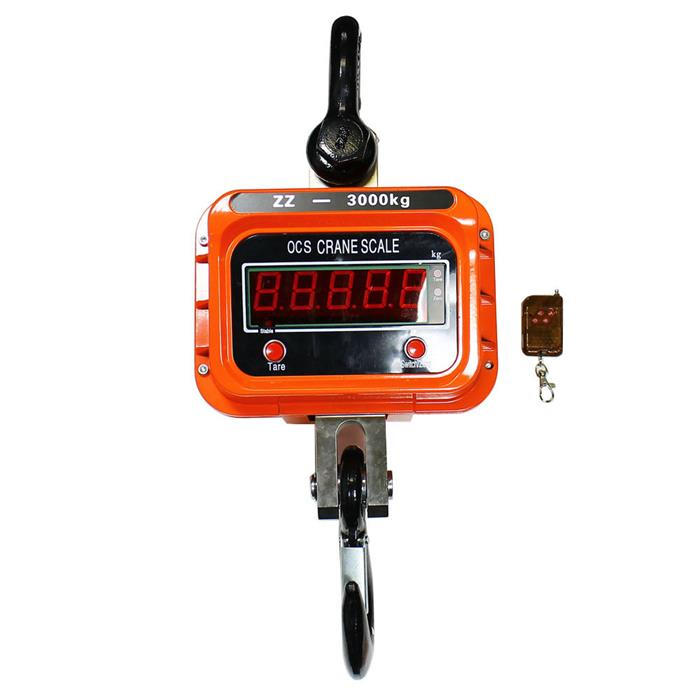
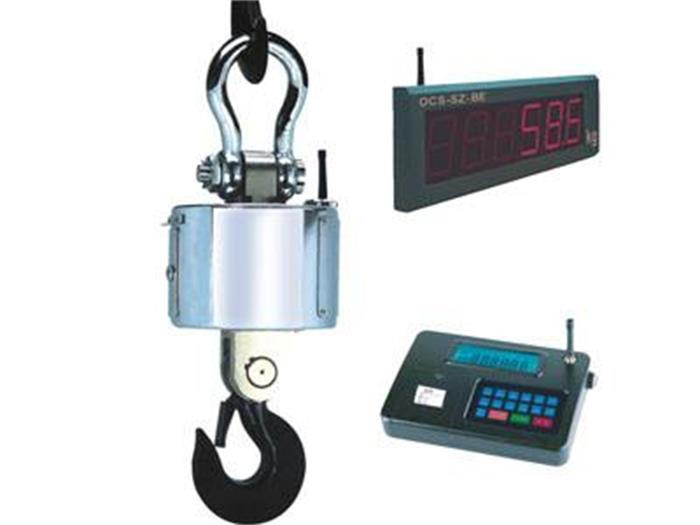

Electronic Crance Scale,Digital Crane Scale,Crane Lifting Scale,Diecast Scale Crane
Hebei Liston Lifting Rigging Manufacturing Co., Ltd. , https://www.liftingriggings.com










